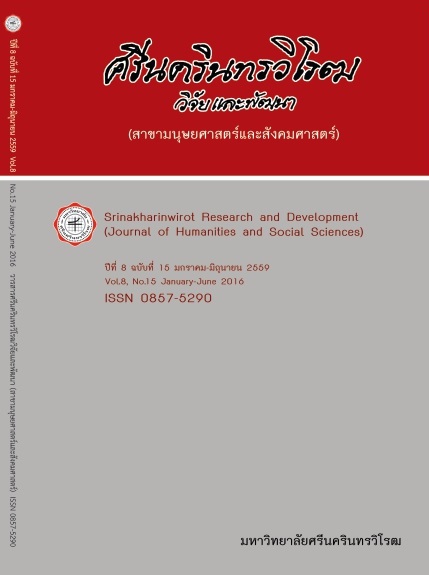รูปแบบการส่งเสริมการใช้ประโยชน์จากโครงการชลประทานในฤดูแล้งจังหวัดยโสธร A PROMOTION MODEL OF THE IRRIGATION PROJECT UTILIZATION IN DRY SEASON IN YASOTHON PROVINCE
Keywords:
รูปแบบการส่งเสริม โครงการชลประทานAbstract
บทคัดย่อ
การวิจัยนี้มีวัตถุประสงค์เพื่อพัฒนาและประเมินผลการใช้รูปแบบการส่งเสริมการใช้ประโยชน์จากโครงการชลประทานในฤดูแล้ง จังหวัดยโสธร การวิจัยแบ่งเป็น 3 ระยะดังนี้ ระยะที่ 1 การศึกษาแนวทางการส่งเสริมการใช้ประโยชน์จากโครงการชลประทานในฤดูแล้งต้นแบบ กลุ่มเป้าหมายคือ ผู้บริหารและเจ้าหน้าที่ของโครงการชลประทานที่ดีเด่นและมีการส่งเสริมการใช้ประโยชน์จากโครงการชลประทานมาไม่น้อยกว่า 5 ปี จำนวน 10 คน เครื่องมือที่ใช้ในการวิจัยคือ แบบสอบถามเกี่ยวกับการดำเนินงานของโครงการ ระยะที่ 2 การพัฒนารูปแบบการส่งเสริมการใช้ประโยชน์จากโครงการชลประทานในฤดูแล้ง กลุ่มเป้าหมาย คือ ตัวแทนจากกลุ่มต่างๆ ประกอบด้วย นักวิชาการอิสระ ข้าราชการ ประชาชนที่อยู่ในพื้นที่ให้บริการน้ำ จำนวน 30 คน เครื่องมือที่ใช้ในการวิจัย คือ รูปแบบส่งเสริมที่พัฒนาจากการนำผลการวิจัยระยะที่ 1 ในระหว่างการประชุมเชิงปฏิบัติการร่วมกันในกระบวนการระดมสมอง วิพากษ์การส่งเสริมการใช้ประโยชน์จากโครงการชลประทานในฤดูแล้ง และข้อเสนอแนะเป็นแนวทางการปรับปรุงและพัฒนารูปแบบ และระยะที่ 3 การทดลองใช้และประเมินผลการใช้รูปแบบการส่งเสริมการใช้ประโยชน์จากโครงการชลประทานในฤดูแล้งที่พัฒนาแล้ว กลุ่มทดลอง คือ ประชาชนที่อยู่ในพื้นที่ให้บริการน้ำ(พื้นที่ชลประทาน)ในฤดูแล้งของอ่างเก็บน้ำห้วยสะแบก ตำบลบุ่งค้า อำเภอเลิงนกทา จังหวัดยโสธร จำนวน 30 ครัวเรือนที่เข้าร่วมการวิจัยโดยความสมัครใจและเจาะจง เครื่องมือที่ใช้ในการวิจัยคือแบบสอบถามและแบบสอบถามความพึงพอใจของเกษตรกรต่อระบบชลประทาน สถิติที่ใช้ในการทดสอบสมมุติฐานได้แก่ F-test
( Repeated Measures MANOVA )
ผลการวิจัยพบว่า แนวทางการส่งเสริมการใช้ประโยชน์จากโครงการชลประทาน ในฤดูแล้ง แบ่งเป็น 4 ด้านดังนี้ 1) ด้านการบริหารจัดการ 2) ด้านการจัดสรรน้ำและบำรุงรักษา มีระบบชลประทานทั่วถึงและส่งน้ำได้ดีมีประสิทธิภาพ 3) ด้านปัญหาและอุปสรรค ได้แก่ระบบชลประทานชำรุด และ 4) ด้านกลยุทธ์ที่ส่งเสริมให้เกษตรกรมีการใช้น้ำในช่วงฤดูแล้ง ได้แก่ การส่งเสริมให้เกษตรกรมีการใช้น้ำในช่วงฤดูแล้ง ดูแลปรับปรุงบำรุงรักษาระบบชลประทานตลอดเวลา อบรมให้ความรู้กับเกษตรกรอย่างต่อเนื่องสม่ำเสมอ จัดทำแผนงานปลูกพืชฤดูแล้งโดยบูรณาการร่วมกับทุกภาคส่วนและจัดหาตลาดรองรับผลผลิตจากพืชฤดูแล้ง รูปแบบการส่งเสริมการใช้ประโยชน์จากโครงการชลประทานในฤดูแล้งที่พัฒนาได้ประกอบด้วย 1) การศึกษาข้อมูลและแนวทางการส่งเสริมการใช้ประโยชน์จากโครงการต้นแบบ 2) การสร้างแนวทางการในการส่งเสริมการใช้ประโยชน์จากโครงการชลประทานในฤดูแล้งโดยใช้ยุทธศาสตร์ 4 ยุทธศาสตร์ และ10 โครงการ ได้แก่ ยุทธศาสตร์การบริหาร ยุทธศาสตร์ด้านการจัดสรรน้ำและบำรุงรักษา ยุทธศาสตร์ด้านการมีส่วนร่วม และยุทธศาสตร์ด้านการพัฒนาความรู้ และ 3) การทดลองใช้
และประเมินผลแนวทางการในการส่งเสริมการใช้ประโยชน์จากโครงการชลประทานในฤดูแล้ง หลังการทดลองเกษตรกรที่เข้าร่วมโครงการ มีจำนวนพื้นที่ที่มีการปลูกพืชฤดูแล้ง (Area) เพิ่มขึ้น 2.57 เท่า รายได้จากการขายพืชผลในฤดูแล้ง (Income) เพิ่มขึ้น 3.94 เท่าและความพึงพอใจของเกษตรกรต่อระบบชลประทาน (Satisfaction) เพิ่มขึ้นจากก่อนการทดลอง (p< .001)
Abstact
The research aimed to develop and evaluate the promotion model of the irrigation project utilization in the dry season in Yasothon province which conducted in three phases. The first phase was the study of guidelines for the promotion of the irrigation project utilization during the dry season. The target group consisted of ten administrators and officers of an outstanding irrigation project who had promoted the utilization of this project for at least five years. The project operation questionnaire was used for data collection. The second phase was the development of the promotion model of the irrigation project utilization in the dry season. Thirty representatives were participated which consisted of independent academics, government officials, and people living in the water service area. The instrument used was the promotion model developed by using the phase one results during the participation of workshop session with the uses of the brain storming, criticizing and suggesting for the improvement and development of the model. Finally, the third phase was the implementation and evaluation of the developed promotion model. The voluntary and purposive sample which consisted of 30 family representatives living in the water service area(Irrigation area) in Hauy Sabak reservoir, Bookkha sub-district, Lerng Nokta district, Yasothon province. The questionnaire and questionnaire about satisfaction with the irrigation system were used for data collection. The F- test (Repeated Measures MANOVA) was employed for testing hypotheses.
The main findings revealed that the guidelines for the irrigation project utilization in the dry season consisted of 4 areas, namely, (1) management; (2) water allocation and maintenance such as sufficient irrigation system and effective water delivery; (3) problems and obstracles such as damaged irrigation system; and (4) promotion strategies for sufficient water usage in the dry season, regular maintenance and adaptation of the irrigation system for farmers’usage, providing continuous and regular training sessions for farmers, making dry season planting plans with every sector participation and providing markets for dry season plant products.
The developed promotion model of the irrigation project utilization in the dry season included (1) the study of data and guidelines for utilization of the prototype project; (2) guidelines construction for the utilization of the irrigation project in the dry season with the uses of four strategies and ten projects. These strategies were management, water allocation and maintenance, participation and knowledge development; and (3) implementation and evaluation of guidelines for the irrigation project utilization in the dry season. The participant farmers showed gains in the increases of crop field at 2.57 times and income at 3.94 times; and showed increased satisfaction with the irrigation system from before participation (p<.001).Downloads
Downloads
Published
How to Cite
Issue
Section
License
Srinakharinwirot Research and Development Journal of Humanities and Social Sciences is licensed Under a Creative Commons Attribution-NonCommercial-NoDerivs 4.0 International (CC-BY-NC-ND 4.0) License, Unless Otherwise Stated. Please Read Journal Policies Page for More Information on Open Access, Copyright and Permissions.



